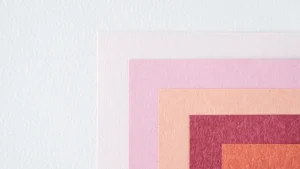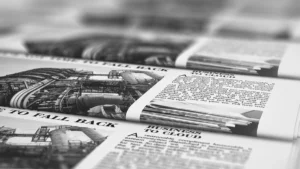At The Printery, every project is handled with care and precision. Our team of seasoned professionals brings decades of experience to the table, ensuring that each print job meets the highest standards of quality.
There are many different types of paper used in professional printing, and each one can completely change how your project looks and feels.
Because every business has unique needs, it’s worth taking the time to find customized printing solutions that match your goals, from the right texture and weight to the perfect finish that brings your brand to life.

Understanding Paper Types and Their Impact on Printing
The paper you choose has a big effect on how your prints look and feel. Each type has its own weight, texture, and finish. These details can completely change the final result.
Here’s how paper type influences your prints:
1. Print Quality
The surface of the paper affects how ink is absorbed and how sharp your images appear.
- Glossy paper brings out bright, vibrant colors.
- Matte paper gives a smooth, clear look with less glare that’s perfect for reading.
- Coated papers enhance detail and color depth, while uncoated papers give a natural, softer finish.
2. Texture
The feel of the paper adds personality to your design.
- Smooth textures create a sleek, modern impression.
- Textured papers, such as linen or laid, give a handcrafted, premium feel.
- Heavier papers feel sturdy and high-end, while lighter ones are flexible and practical.
3. Presentation
The right paper helps your project look professional and aligned with your brand.
- Thick, glossy stock makes brochures or posters stand out.
- Subtle matte paper fits elegant, minimalist designs.
- Recycled or natural papers show eco-friendly values.
By understanding these qualities, you can choose the paper that best fits your project, whether you want it to look bold and colorful, soft and refined, or simple and professional.
Common Types of Paper in Professional Printing
In professional printing, the type of paper you use depends on where it will be used and the kind of impression you want to make. Each type serves a different purpose.
Here are some of the most common ones you’ll come across:
1. Office and Everyday Papers
Used for daily printing tasks like reports, letters, and forms.
- Bond paper – strong and slightly textured, often used for official documents.
- Copy paper – thinner and ideal for printers and copiers.
- Matte paper – smooth, non-shiny surface that’s easy to read.
2. Marketing and Business Materials
Perfect for items that represent your brand, such as flyers, brochures, and business cards.
- Gloss paper – gives a shiny finish that makes photos and colors pop.
- Silk or satin paper – a soft, semi-gloss finish that looks elegant without glare.
- Uncoated paper – has a natural texture, often used for letterheads or premium stationery.
3. Restaurant and Retail Prints
Made for heavy use or environments where spills and wear are common.
- Synthetic paper – waterproof and tear-resistant, great for menus.
- Laminated paper – coated for extra protection against stains and moisture.
4. Creative and Specialty Papers
Used when you want to make something feel special or unique.
- Textured paper – adds depth and a tactile feel, ideal for invitations or certificates.
- Recycled paper – an eco-friendly option that shows environmental awareness.
- Colored or metallic paper – adds flair for event materials or premium packaging.
5. Large-Format and Display Papers
Designed for posters, signage, and architectural plans where size and clarity matter.
- Poster paper – durable and designed for vivid, high-quality color prints.
- Coated wide-format paper – enhances color accuracy for presentations or ads.
- Blueprint paper – used for technical drawings and construction layouts.
Each type of paper creates a different look and feel. By choosing the right one, you make sure your prints match your purpose.
Choosing the Right Paper for Your Project
Picking the right paper can make your project stand out. Think about how you want people to see and touch your work.
Here’s how to choose what fits best:
1. Start with Purpose
Ask yourself: What will this be used for?
- If it’s an office document, go for simple, lightweight bond or copy paper.
- For marketing materials, choose something that looks professional (glossy or silk paper works great).
- If you’re printing menus or outdoor signs, use synthetic or laminated paper that can handle spills and wear.
2. Match the Finish to the Feel
The finish changes how your design looks:
- Glossy – shiny and eye-catching, best for colorful designs or photos.
- Matte – smooth and soft, easy to read, ideal for text-heavy designs.
- Textured – adds character and a premium touch to invitations or certificates.
3. Consider Weight and Thickness
The “weight” of the paper affects how sturdy it feels:
- Lightweight (70–100 gsm) – best for everyday use or multi-page documents.
- Medium weight (120–170 gsm) – good for brochures or flyers.
- Heavyweight (200+ gsm) – feels premium, perfect for business cards, postcards, or covers.
4. Match the Color and Tone
Paper color affects how your print turns out:
- White or bright white – makes colors vibrant and text crisp.
- Cream or off-white – adds warmth and softness for a refined look.
- Colored paper – adds personality or brand identity to your print.
5. Work with a Printing Expert
If you’re unsure, talk to your printer. For example, you can:
- Compare paper samples to see and feel the difference.
- Get advice on the best type for your project and budget.
- Choose from premium stocks that make your brand stand out.
When you choose the right paper, your print doesn’t just share information, it tells a story. Every texture, weight, and finish adds to how your brand is seen and remembered.
And that’s where expert guidance truly makes a difference.
Having a team that understands how to bring those choices together into one cohesive, professional result.
How The Printery Customizes Every Print
Your project is a reflection of your brand. That’s why every detail, from paper type to finish, is customized to fit your exact needs.
When you work with The Printery, you get more than just printing. You get expert guidance and premium options that make your materials stand out.
Here’s how the team helps you bring your ideas to life:
- Personalized Paper Choices: You can choose from a wide range of paper types, including smooth bond paper for documents or thick cardstock for business cards, invitations, and packaging that need a sturdy, professional feel.
- Premium Stock Options: The Printery offers high-quality coated, uncoated, textured, and specialty papers to match your brand’s personality, whether you want something glossy and bold or matte and refined.
- Expert Recommendations: Not sure what to pick? Their experienced team can help you compare samples, explain the difference between finishes, and suggest what works best for your design and budget.
- Attention to Detail:
Every print is checked for color accuracy, clarity, and consistency to ensure your materials look as professional as your brand.
We don’t just print, we help you bring your brand to life through thoughtful choices in texture, quality, and design.




